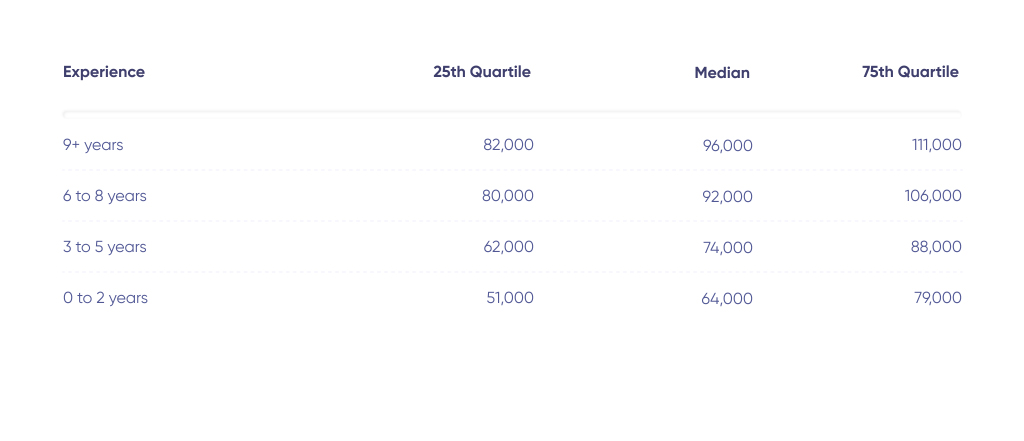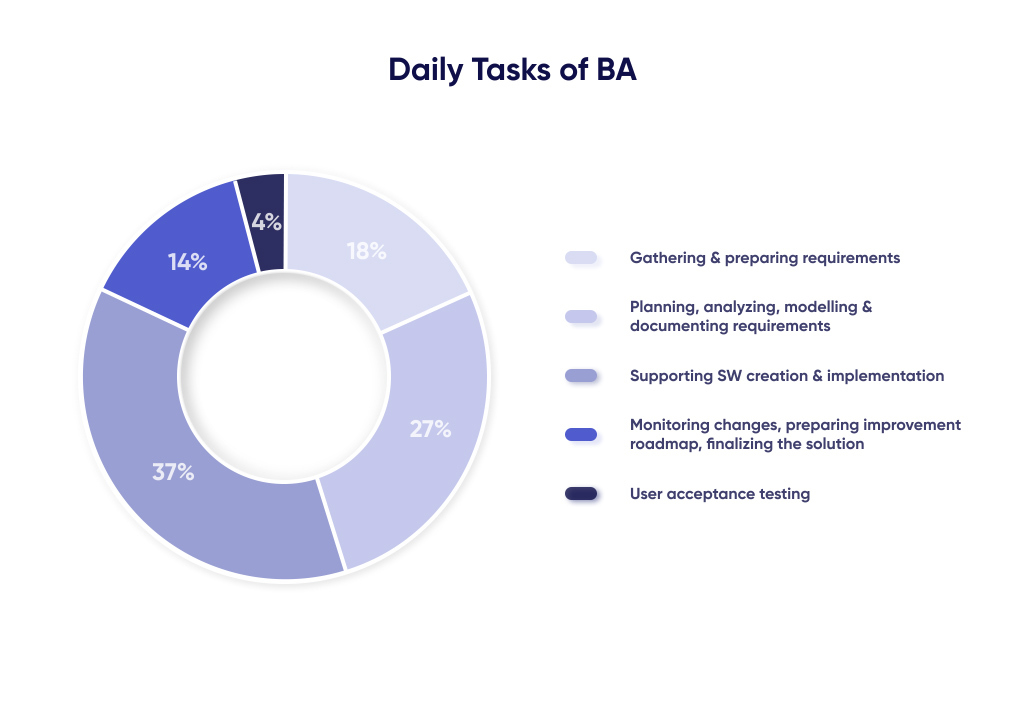Each business demands satisfying its needs. If this does not happen, there is a feeling that something went wrong. For example, you lag behind competitors, lose customers, the quality of products falls, and employees' motivation decreases. Business sees this as a problem, and all these things are just its indicators. Here, as in a parable: young parents asked the guru: "Our child is three months old. When to start his upbringing?" The guru replied: "You are three months late." The same thing is with business analysis. It should always come first. BA in software development should appear in the project from the first day of its launching, or the first days of setting a company — or better, even before that. The strategic goal and development plan must be in place even before the company is formally set out.
What is the Role of Business Analyst in Software Development?
Before launching the project, you need to determine which solution it is aimed at, its scope, how the business process is arranged now, what project should become, its boundaries, and its success criteria. While seeking answers, you may face that each of several influential stakeholders on the client's side has their own vision of the project. If not streamline the varying perceptions into a shared vision, the project can stop at any time. In the other case, the project may proceed, and the context may change: what was very important yesterday may become secondary today, or there can be a change in regulatory requirements, the system's interface, a solution/project integrated. All these changes require to be managed. This means that someone needs to take over the functions of moderator/facilitator, run a series of discussions, and build a shared vision. At this stage, business analysts appear. Business analysis plays an indispensable role in information technology today, providing links between information technology capabilities and their bump on a company's business goals.
Business Analyst Short Job Description
A specialist is often referred to as a BA and called upon to help a company sustainably develop by shaping new or improving existing business activities, chief and supporting business processes following its strategic goals and stakeholder requests. It is a primary person responsible for ensuring cooperation with user representatives and other parties interested in the project. BA analyzes the business needs, investigates a problem, and produces its concept in the form of requirements, followed by software developers when designing a product.
BA is also a communication broker, clarifying vague user perceptions and converting them into precise specs that guide the product development team.
Business Analyst Salaries in the IT
The market demand for professional business analysts has increased significantly over the last few years and this trend is expected to continue. In fact, the BA market is forecasted to grow 14.3 percent over the next decade.
In this regard, the matter of business analyst salaries in IT is equally important both for the applicants and the employers. Figuring out the average salary, the job seekers are willing to find out whether or not this position is advantageous and well paid. And for business owners knowing the salary bracket is a handy tool that helps quickly evaluate the candidates.
As for the actual numbers, today, the global average salary for a Business Analyst is $74,000. In the US, the highest BA salary is $116,940 in NYC, and the lowest is $68,900 and around $21,600 in Poland and Ukraine.

What Does A Business Analyst Do in The IT Company?
Most people believe that developing a program or an app requires software developers to write the code, and that's all necessary to make the customer's dream come true. There is an absolute chasm between what the client says and what the programmer will eventually do. That is because the customer thinks on the scale of the ultimate goal: what the software should do and what he wants to use it for, while the programmer is obliged to ponder over the implementation details: how the program should work and how to do that in the right way.
Information technology business analysts identify the existing customer's business challenges and turn them into reliable and effective solutions.
Role of Business Analyst in Software Development Life Cycle
In consumer product companies, the IT business analyst role is often represented by the product manager or marketing person. In essence, the product manager operates as a business analyst, often emphasizing understanding the market landscape and anticipating external users' needs. But, suppose the project has both a product manager and a BA. In that case, the former usually concentrates on the external market and user requests, while the latter translates this information into requirements.
BA's primary role is to identify business requirements and convert them into a solution by figuring out why users need a new application and then defining the user, functional, and non-functional requirements that teams can use to evaluate, plan, design, and build a product.
The BA’s main responsibilities do not change that much in product-based and service-based companies. But, for sure, there are some differences in the working style. Business analyst in product-based companies concentrates on the particular product’s features and domain. There’s not a lot of switching from one client to another as the employees are working on certain software and their company, in a way, is the client. BA in service-based companies has to demonstrate flexibility. There usually are multiple projects that may relate to different domains and/or technologies. The risk of unexpected changes per customer’s request is also higher.
Stakeholder Analysis
Analysis of all the connections is one of the initial BA steps within the project. A business analyst examines the structure of the team and the number of people with whom the BA will work; management structure — who reports to whom; client — background, expectations, priorities. In a normal situation, the PM conducts onboarding for the BA and answers questions. If this does not happen, the business analyst needs to proactively find answers because stakeholder analysis provides an essential context for functional and feature preparation and implementation into the solution.
Documentation Of Requirements
The business analyst in information technology works with specifications at all stages of the product development lifecycle and continuously acts as a liaison between the customer and the team. (S)He produces required documentation (requirements) to keep everybody on the same page by understanding stakeholders' vision and translating it to all involved in the project. Requirements are clear descriptions of what needs to be implemented in a product: system behavior, properties, and attributes.
The documents that describe different types of requirements are divided into three levels:
- PRD — Product Requirement Document — describes the product your company will build. It drives the entire product team's efforts and sales, marketing, and customer support efforts. It's hard to develop a more important, higher leverage piece of work for a company.
- BRD — Business Requirement Document — business requirements. Goals and tasks that the user can solve using the system.
- SRS — Software Requirement Specification — special documentation containing information about how the system should behave, what functions it should perform, what load it should withstand, etc.
BA works with specifications at all levels and with SRS documentation and can be assisted by a team lead or a technical project manager.
Tools Of BA
An experienced analyst possesses a wide range of techniques, and (s)he knows when to apply them and when not. To collect precise specifications for the successful product implementation, a business analyst must be able to:
- Analyze the problems and needs of the user.
- Visualize information for the customer and the team.
- Create and maintain project documents.
The software required for effective BA operation can be conveniently classified into the following groups:
Essential tools:
- Creation of documents, images, presentations, digital tables, prototypes: Google docs, inVision Studio, etc.
- Organization of online interactions and correct collection of requirements: Confluence, and similar tools.
- Modeling and diagramming: Miro, Cawemo, Diagrams.net, etc.
Supplementary tools:
- Monitoring the solution performance, data analysis: Google Analytics, Open Web Analytics, QlikView BI, Tableau, etc.
- Analyzing competitive environments: SE Ranking, Ubersuggest, SEMrush, SimilarWeb, SEOPressor and others.
Why A Business Analyst In A Team Means Savings
From the point of view of the team, the quintessential task of BA is to reduce uncertainty. It is not enough to do things right (we have excellent technical expertise and best practices in creating complex solutions). Still, we also aspire to do the right things and translate the complicated business processes into simpler tasks to solve the client's business problems. The presence of a business analyst in the team can help reduce expenses. It may seem that one more person on the team requires additional investment, but in the long run, this leads to a decrease in value. ROI of Business Analysis = (Rework Costs Avoidance) / Price of Business Analyst. Reducing the amount of work required to achieve goals is a cardinal element. Clarifying all stakeholders' needs, creating an overall agreed picture, linking all requirements to business goals — all this allows you to avoid numerous redesigns in the future.
Strong Sides and Weak Sides Of BA
The business analyst profession's main advantage is the ability to penetrate the core and be profoundly insightful: to understand things and how they work, what parts they consist of, how they are connected and interact with each other, and then describe complex things using simple but useful models.
But it won’t be fair not to mention the flaws that come with the perks of being a professional BA. Eliciting requirements can be stressful. So is the constant battle for predictive accuracy. The business analyst should be ready to make the decisions within the restricted timeframe and to adapt according to changes in requirements, context, risks, and needs.
One Day Of Business Analyst In IT
Let's dive into a typical working day of a business analyst covering all of his primary functions. Of course, not all BA workdays go precisely this way. Based on the current tasks and the stage of project development, BA adapts, but in an ideal world without burning deadlines, the analyst's schedule looks like this.

10:00 —12:00 Working with the team
In some cases, communication with the team can take almost the whole day. In an ideal agenda, BA participates in discussions and brainstorms the critical points with the team. The course of execution may turn out additional technical limitations, and the previously approved solution will take much longer. BA organizes a meeting to synchronize the team with the initial business need and asks if the team can develop a solution that takes less time and resources. If a better option is available, then the business analyst changes the requirements. The BA always needs to clearly understand how vital a particular requirement is to the client and whether changes need to be further discussed with him. At first, it's better to ask everything. Understanding in which situation you can decide on your own comes with experience.
What is essential when working with teams:
- Be ready to work with ever-changing needs
- Focus on determining the problem: find out the point, turn the conversation into a positive-constructive channel, and offer an alternative solution
- Escalate issues on time: do not try to solve everything yourself
- Understand and discuss the challenges that the project may encounter in case of some changes
- Notify stakeholders in time. It is vital not to get hung up on communication with the team and understand when all current issues are resolved, and concentrate on other tasks
12:00 —14:00 Writing And Working With the Documentation
At this stage, business analyst deals with business processes modeling:
- Creates specifications.
- Describes user stories/acceptance criteria/use cases.
- Formulates non-functional requirements — describes the conditions under which the system is effective. Such as: "The system must be fault-tolerant and compatible with Google Chrome."
- Simulates business processes.
- Prototype solutions.
What is essential when writing specs:
- Determine the required artifacts in advance.
- Describe the requirements in detail.
- Follow the principles of usability.
14:00 —15:00 Lunch
Lunch is an ideal opportunity to get to know people and chat with the team in an informal environment, so it is advisable not to dine alone.
15:00 —18:00 Communication With The Client
Negotiation is one of the main functions of a business analyst. BA needs to understand the business's subject area. There is always a collection, identification, and clarification of requirements during interviews, demonstration of documents, prototypes, models, diagrams, product demo, or even a ready-made solution.
At the first stage, BA needs to meet with the client, study his problem, analyze, offer ideas and draw up, in a first approximation, a scheme of work. It may also happen that the client does not clearly understand what he wants or cannot formulate the problem. The main task in this case, as marketers say, is to identify the need. Workshops are those meetings where you can learn about the requirements and get to the bottom of the client's real needs. In other words, to answer the question "why do we need this?" and think if the solution is optimal or there are still better options. As the project progresses, BA shows the client the results, the coordination of product changes.
It may happen that a client suddenly reconsiders doing (or not doing) something and wants to make corrections on the fly or even after the end of the sprint (this is called a Change Request). Well, yes, it's not just a pain for designers. When it comes to code changes, things are much more complicated, and BA deals with all that.
18:00 —19:00 Consultations With Tech Leads
When BA drafts requirements, he must understand all related technical details. It is imperative to consult with those engaged in development: architects, team/tech leads, and subject specialists. At such consultations, high-level requirements are discussed: how best to design, implement, decompose, and so on. BA's direct responsibility is to study the subject area from all perspectives: the business and technical aspects.
How to become a business analyst and where to go next?
- To be a business analyst means to be a multi-faceted professional with knowledge in almost all areas. This is the first step towards becoming a BA: to understand who these "miracle healers" are, structure all your developments, understand gaps, and try to fill them in with strong knowledge as soon as possible. These can be online courses, books on introduction to the specialty, feature articles, educational portals, and many other sources. In the digital age, finding the information you need is not difficult.
- Identify the skills that make you a unique specialist. Compare yourself with employers' requirements, improve academic knowledge level (do not underestimate this, knowledge, in theory, is a hallmark of professionals).
- Once you have gained confidence in choosing a profession and your background is enough for real tasks, it's time to get hands-on experience and real feedback. At this stage, you can no longer mindlessly click on vacancies and dream of six-digit numbers in the "salary" column. It is necessary to formulate your capabilities and act purposefully clearly. Most likely, your first job will not be your childhood dream. But there you can learn everything useful in the future for a successful career.
- Practice makes perfect. Of course, understanding technical processes can come in handy, but more to optimize and improve the quality of your work. If you have a technical mind, then everything else is not a problem. The main thing is to understand the structure of business processes. Again, there is plenty of materials and literature on the Internet for every taste. Plus, courses - there you can also get feedback from colleagues and teachers.
As for personal qualities, BA must:
- Have extensive analytical thinking to define customer's business needs accurately and turn them into functional specs
- Easily navigate in an unexplored area
- Must be a creative thinker who can provide alternatives to existing or proposed solutions
- Have coping skills and be able to make swift decisions if the situation requires
- Perfect the operational mindset. You should be able to see a full picture and validate the requirements based on the knowledge of the enterprise as a whole
- Quickly learn new material, be it new ways of working with requirements or features of the subject area
- Improve interpersonal and communication skills — written and oral — the ability to tailor the message to different audiences
- Master the art of the interview and asking the right questions
- Learn the skill of active listening
- Be attentive to details
- Creating comfortable communication conditions: organizing a friendly atmosphere to clarify requirements is an analyst's essential skill. Building trust can lead the organization to success
- Express ideas in an understandable way
- Have a zeal to make a difference
- Be proactive, dynamic, coupled with strong business knowledge
Short Checklist For Business Analyst Skillset covers:
- Understanding your specific role as a business analyst in your company, as the tasks from project to project, can vary greatly;
- Identify all the problem areas that need to be analyzed;
- Know the software life cycle following different methodologies;
- Understand the basics of programming, testing, algorithms, economics.
- Reading BABOK and Software Requirements (Developer Best Practices) by K.Wiegers.
- Highlighting missing competencies and undergo training on them.
- Mastering the basic BA techniques and implementing them into work, and tracking the results.
- Applying for a junior position with a cover letter. Write down why you want to work in this company and why they should hire you: add what you did for this, what courses you took, and what you can do. Don't be afraid to add test projects to your portfolio — they can be an excellent example of your work experience.
When To Apply Business Analysis
The world is on the brink of a technological revolution at the moment and it’s not the best time for conservative and rigid business strategies. Change is the key word for any type of business. And being the main power behind identifying, articulating, and introducing the need for changes in business processes, business analysts are in high demand on the job market.
The pro business analyst is a perfect bridge between information technology and business, which brings maximized value with the power of monitoring, analytics, and data-driven recommendations. Hiring an experienced BA (or even several of them) is the sure-fire way to streamline the software development process and receive a beneficial product in the end.
The job of a business analyst isn’t easy in any way. It’s strictly structured, requires constant adaptation to both development and business environments, demands exceptional attention to detail, and often offers limited decision-making time. But in the end, it all pays off as the software created with the help of business analysts truly makes a difference.





